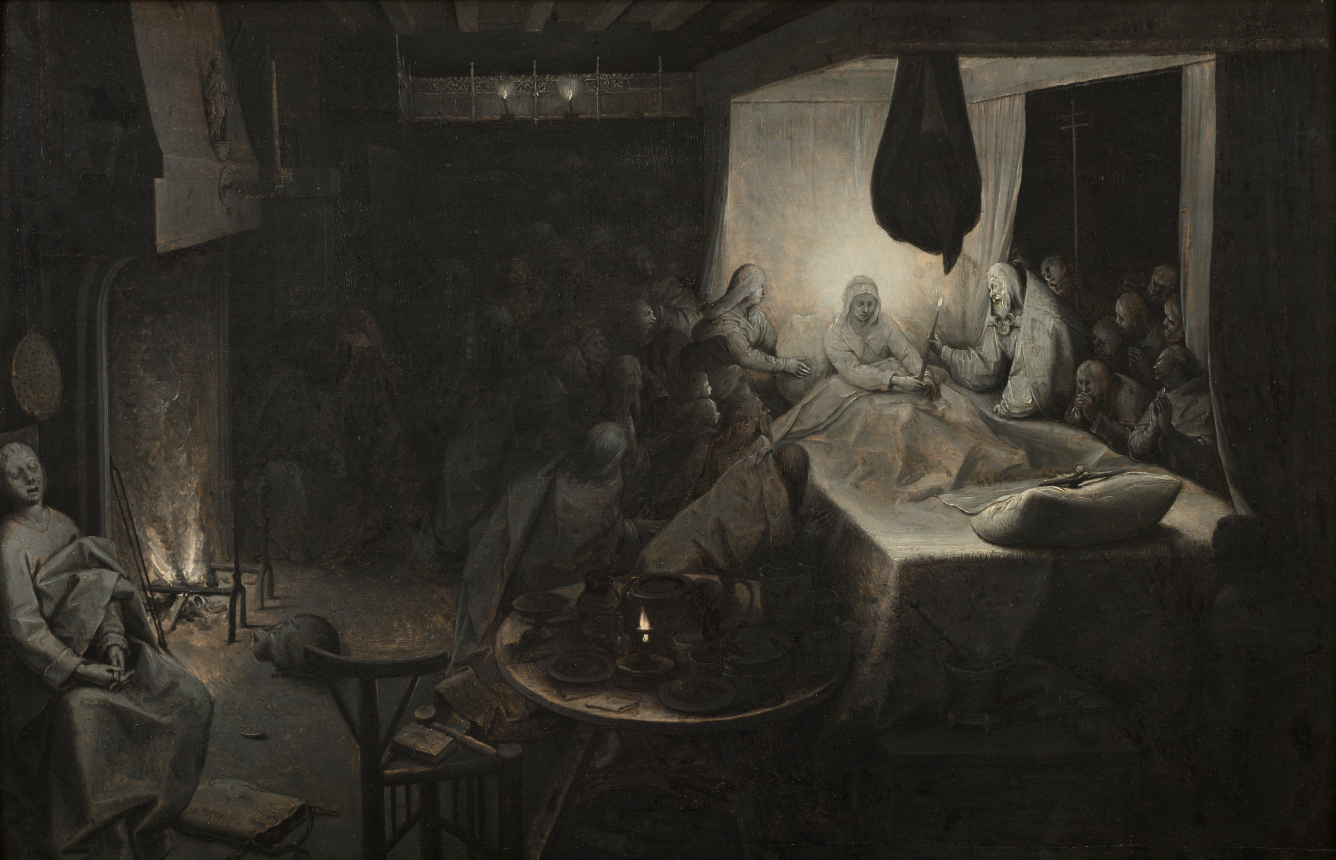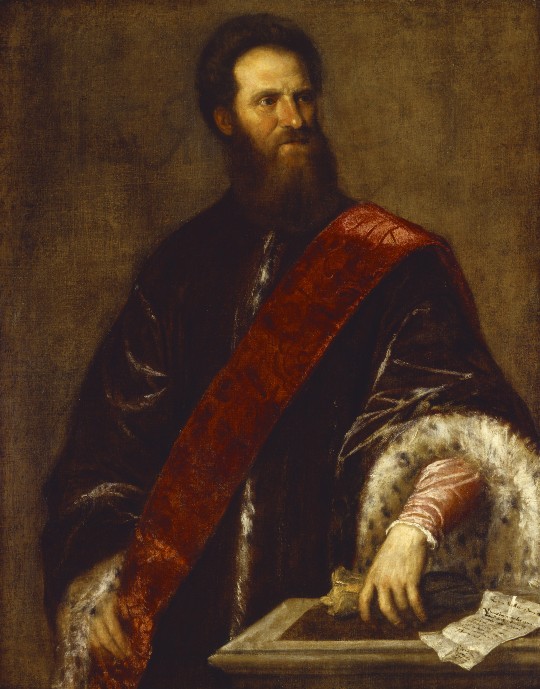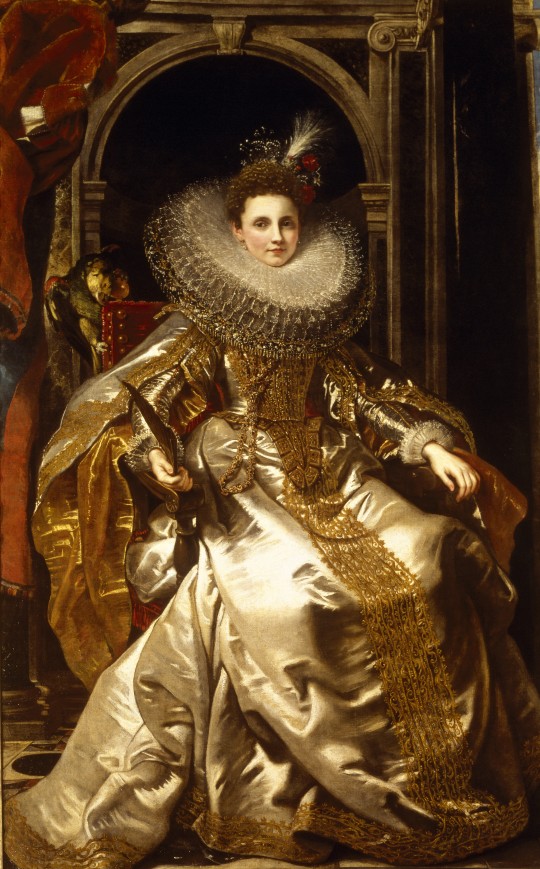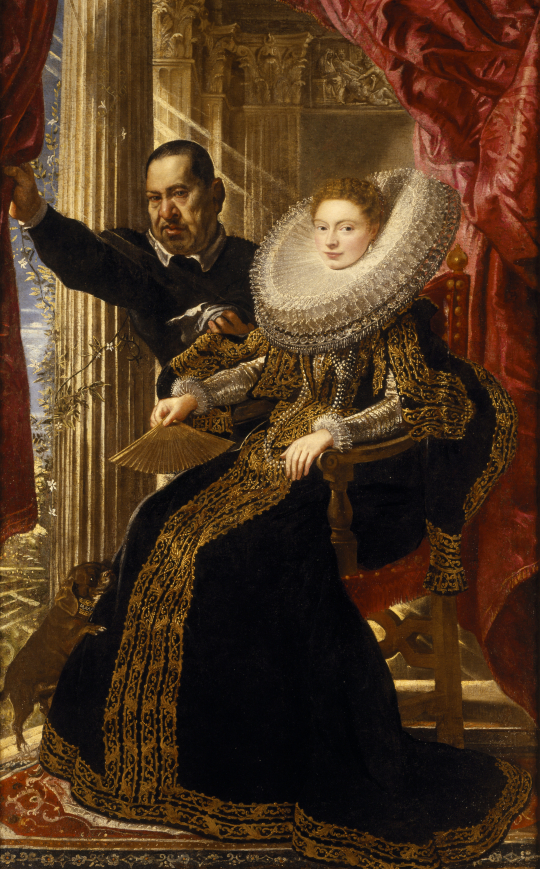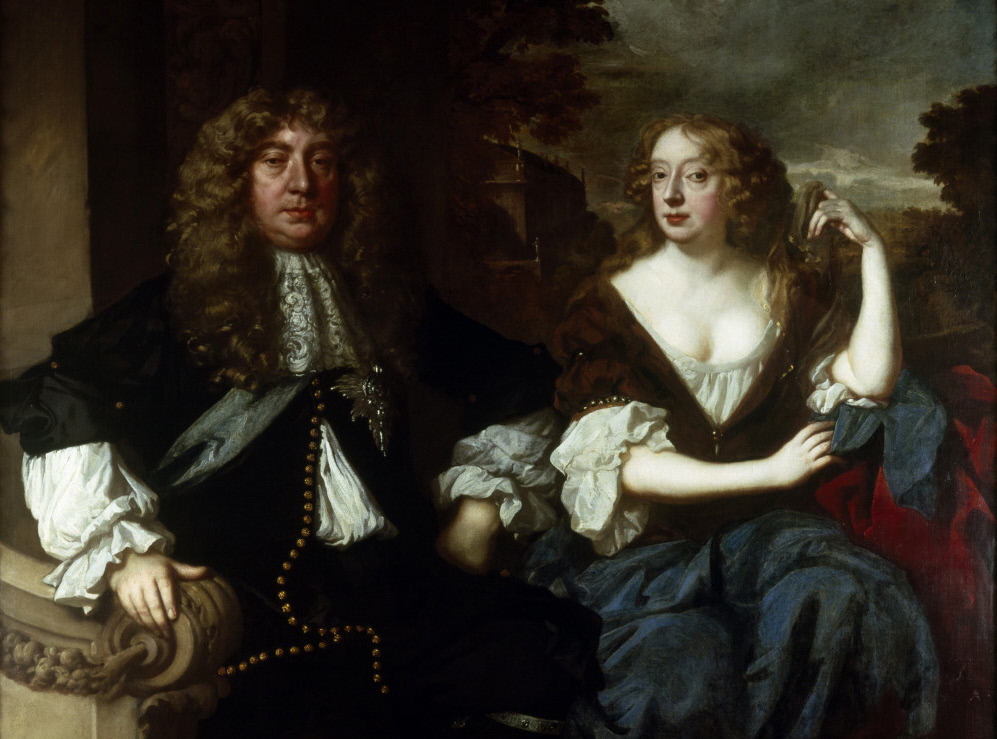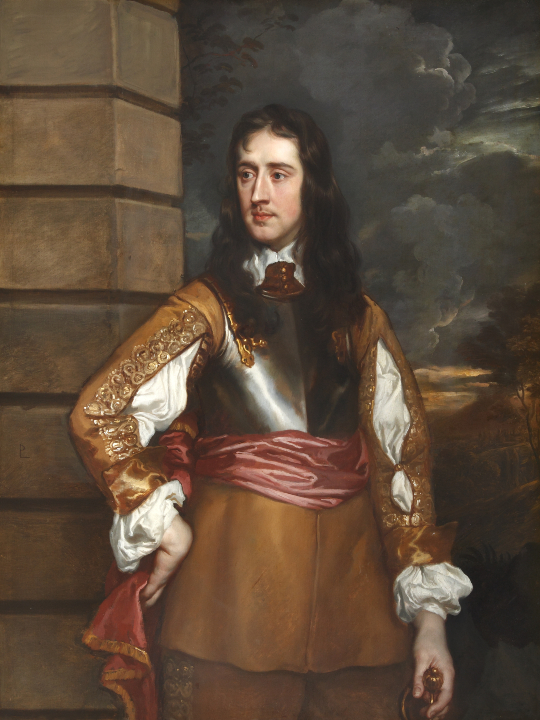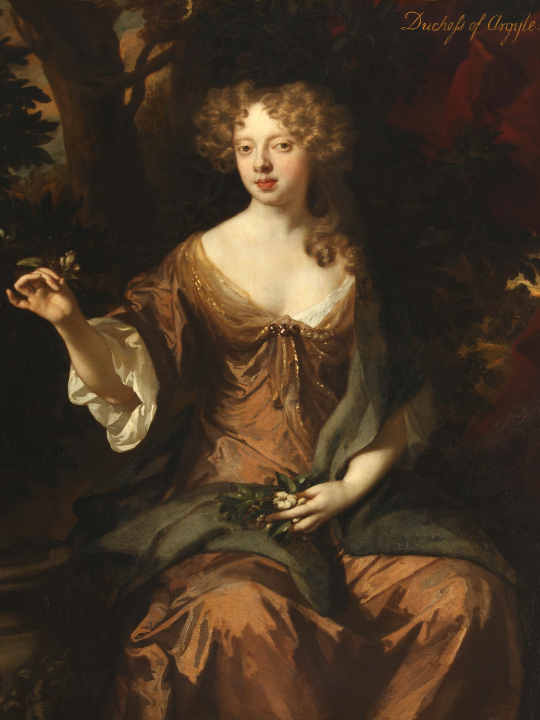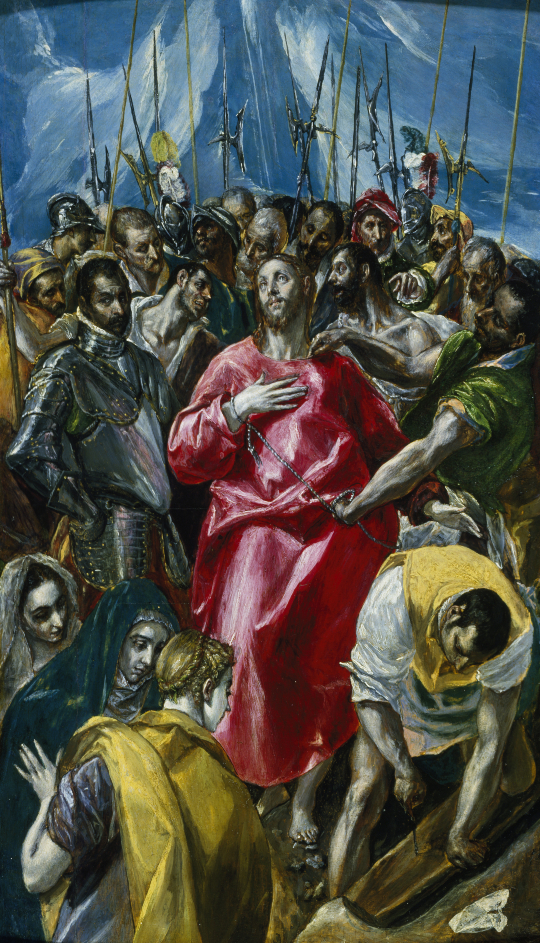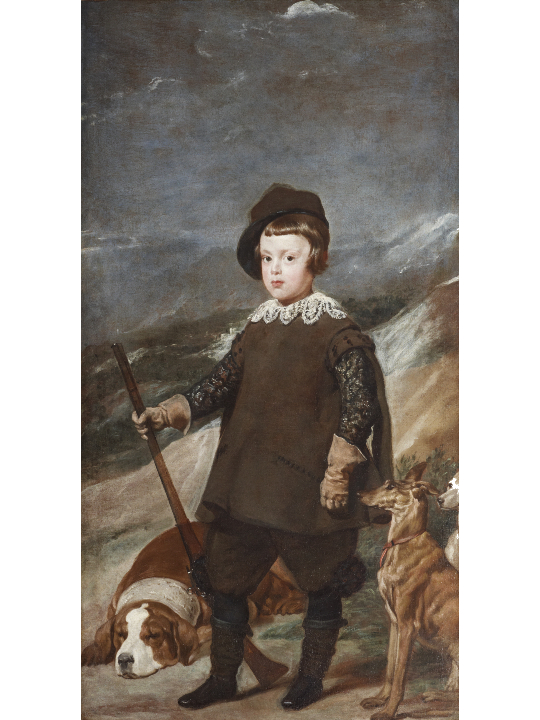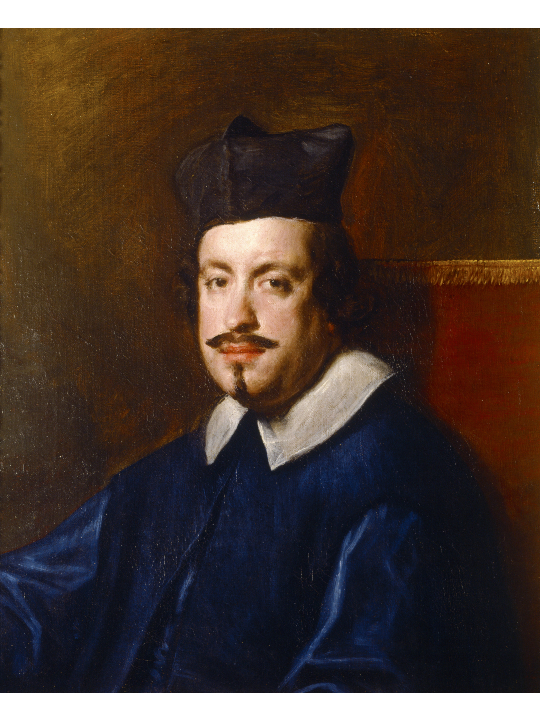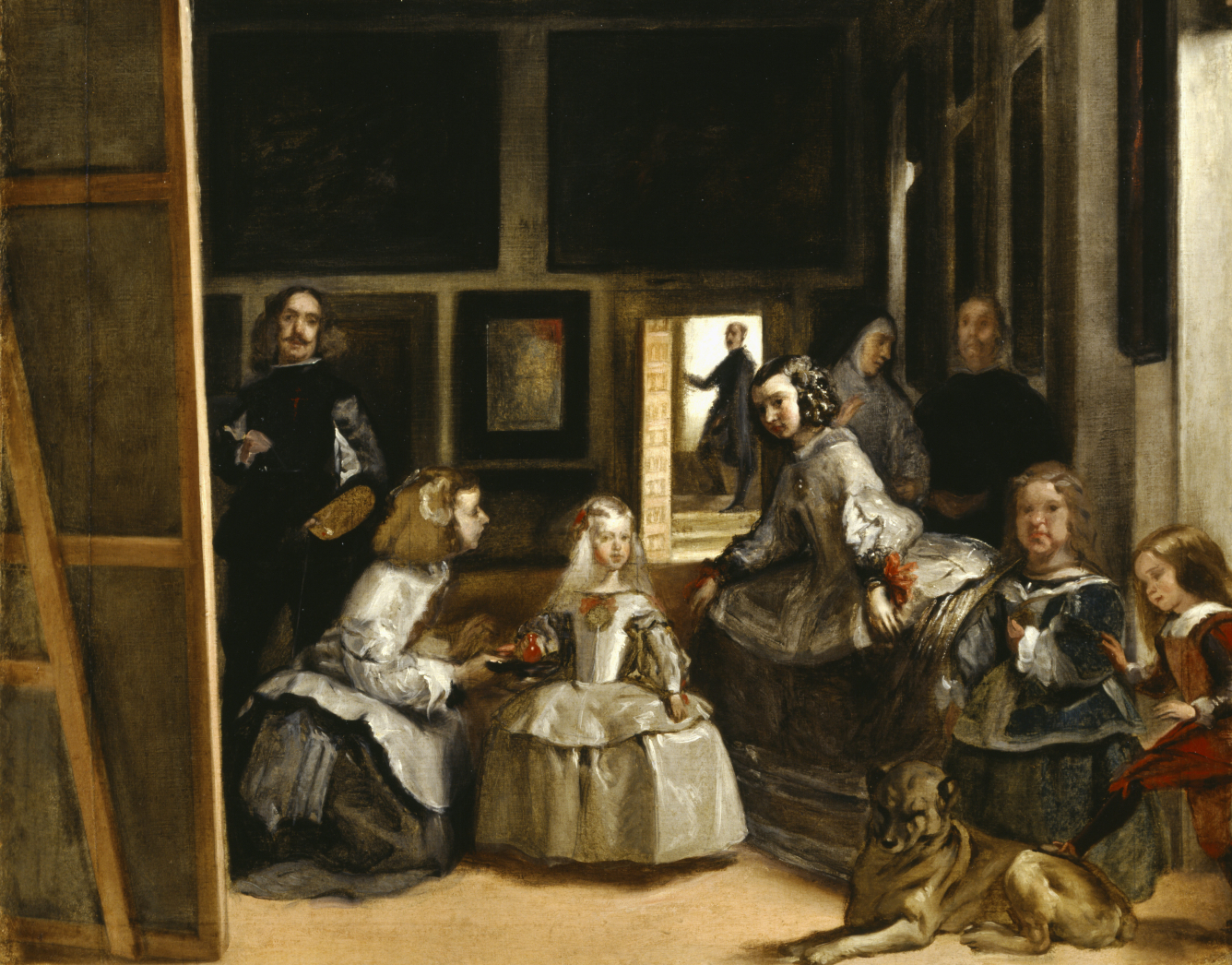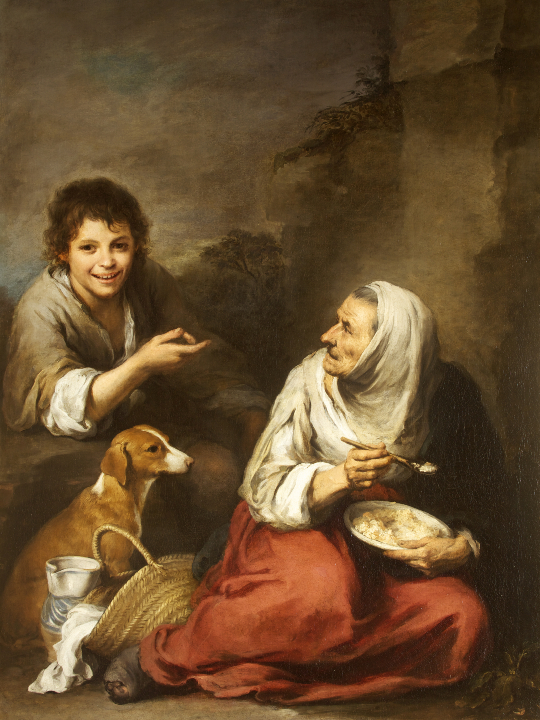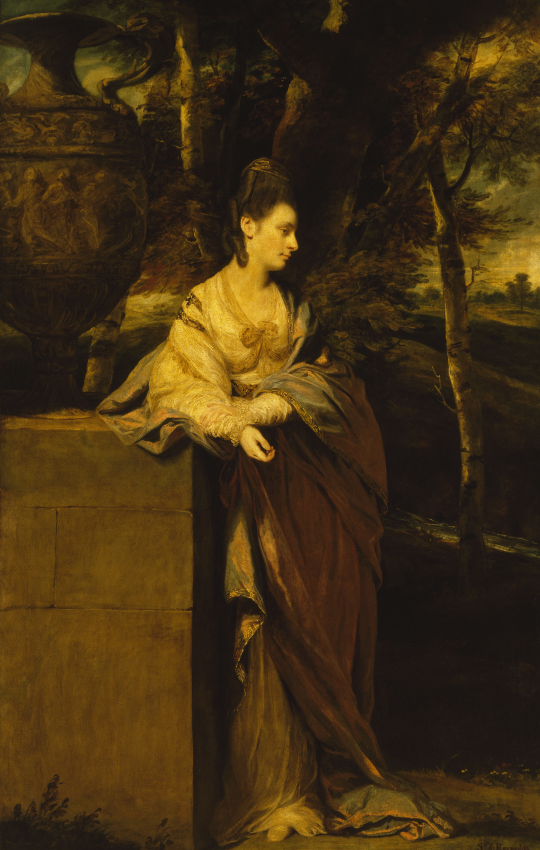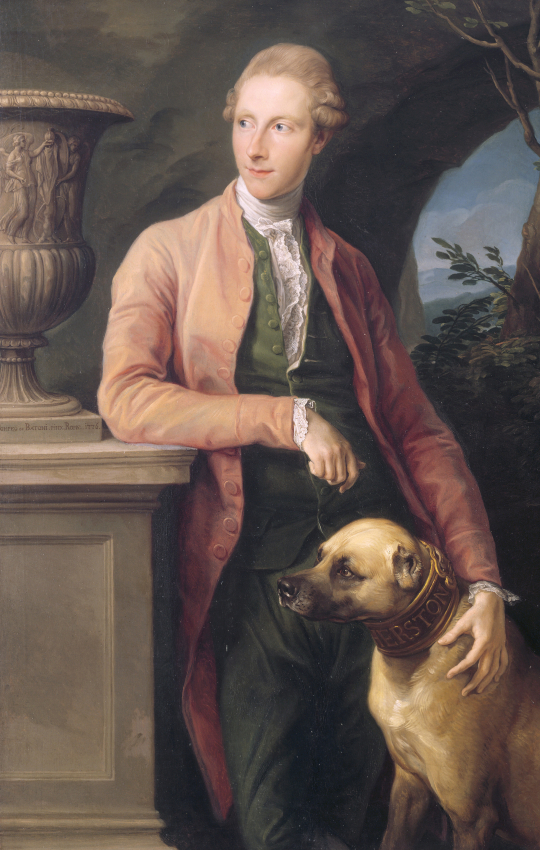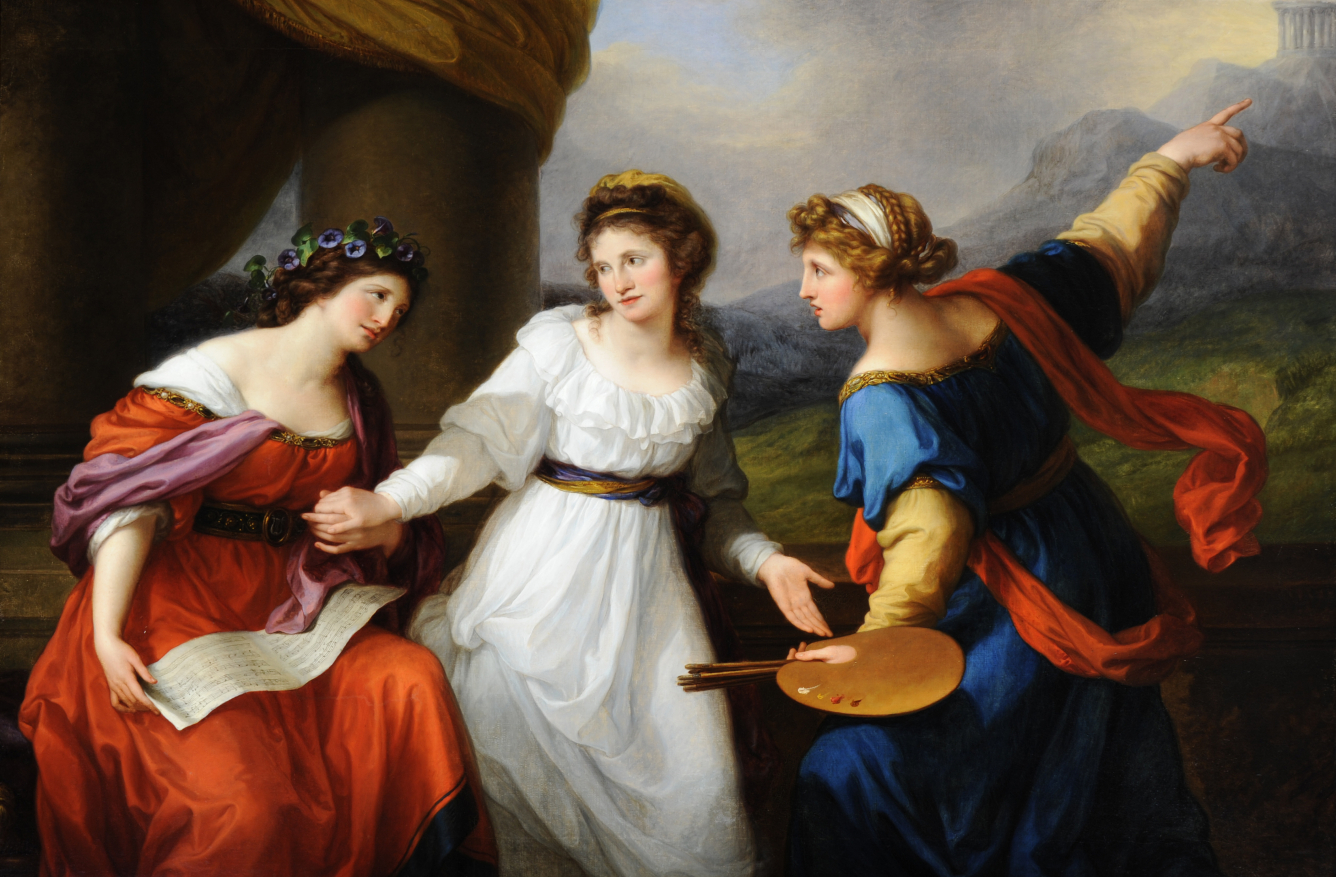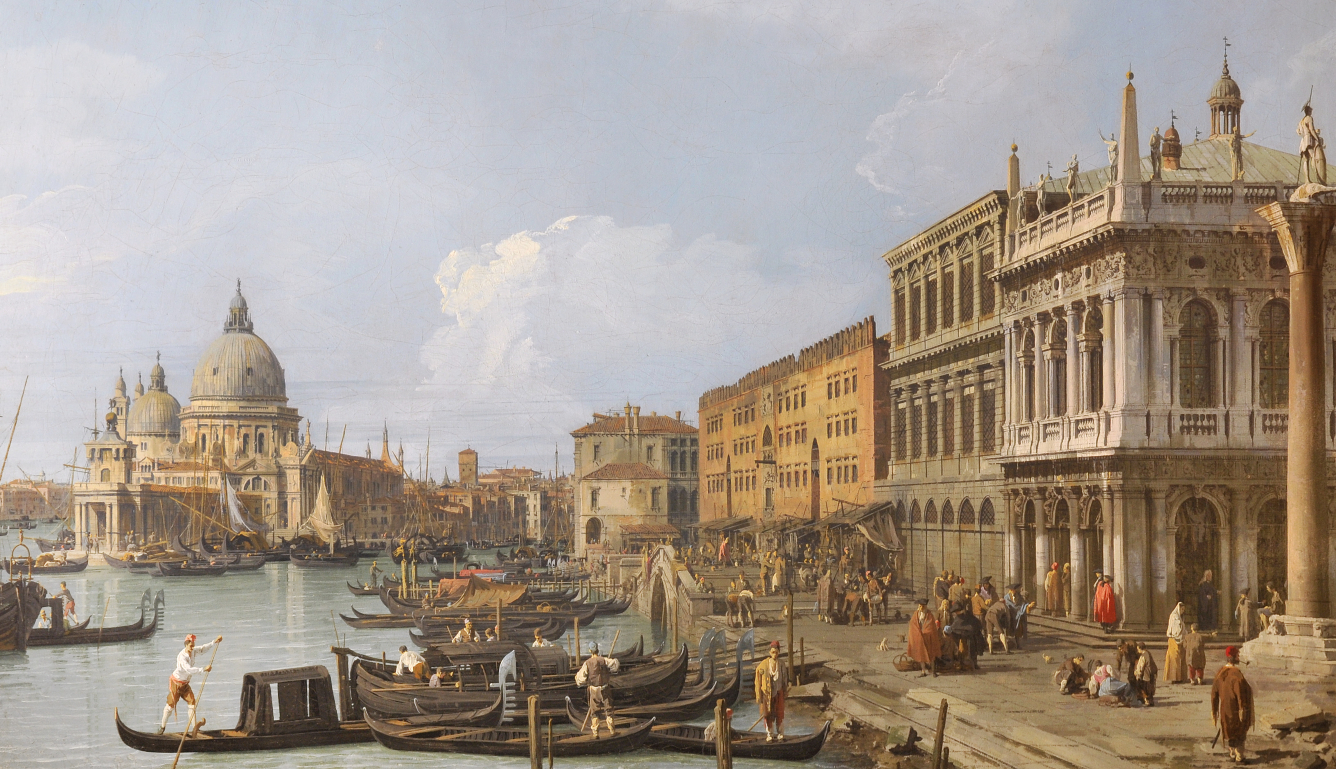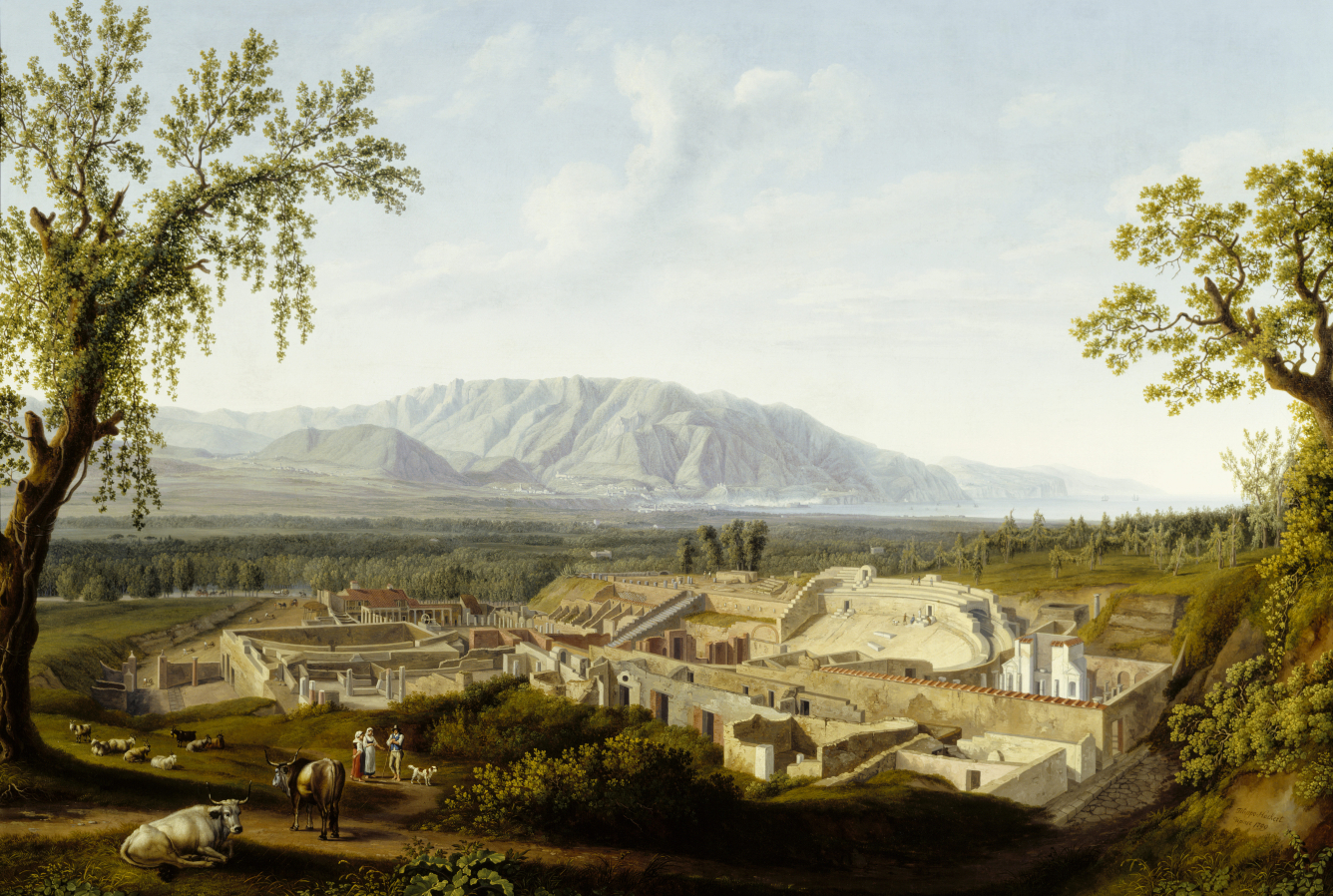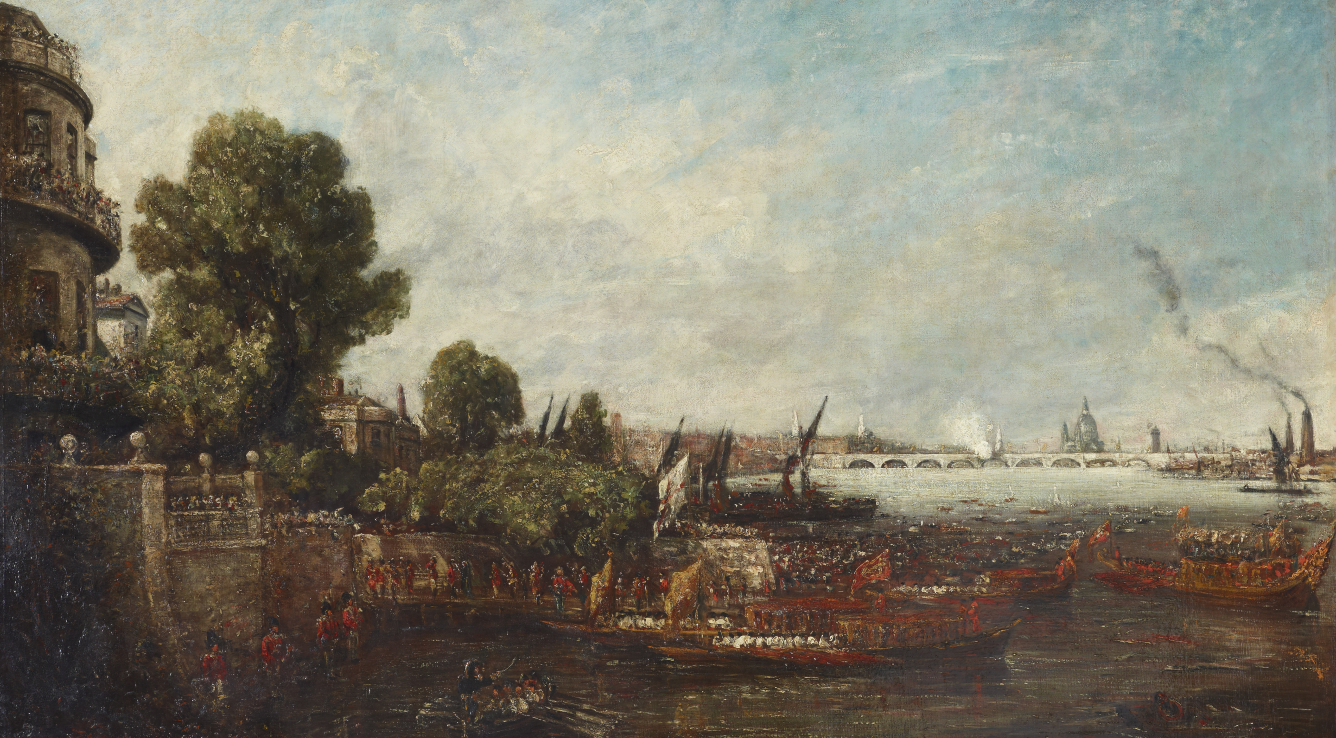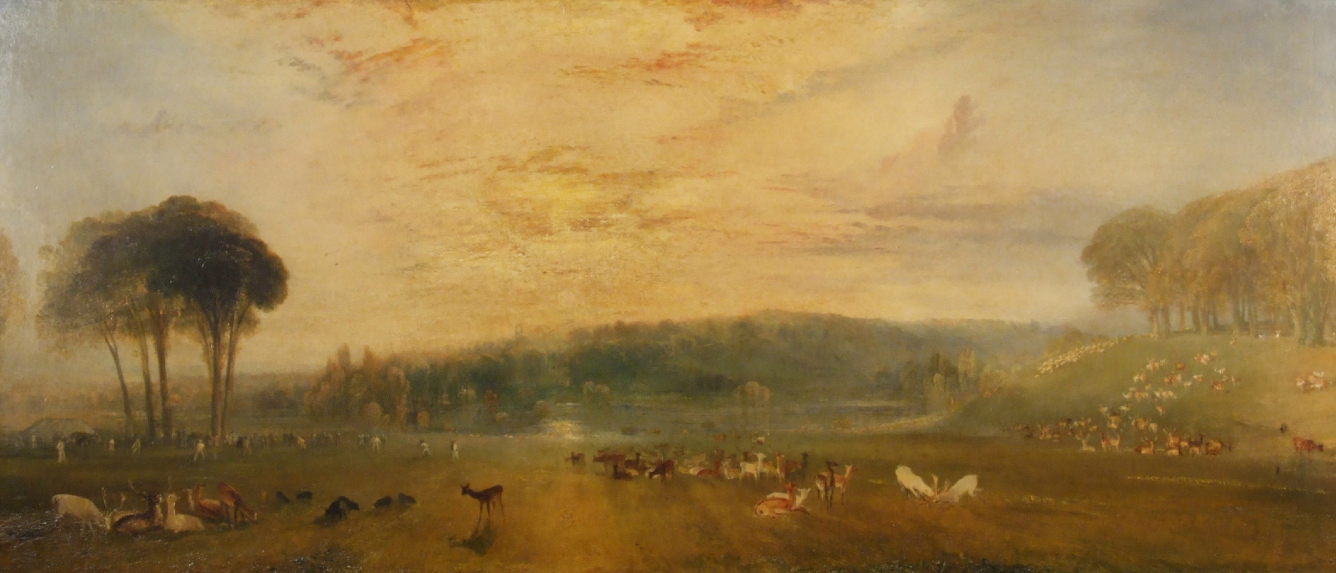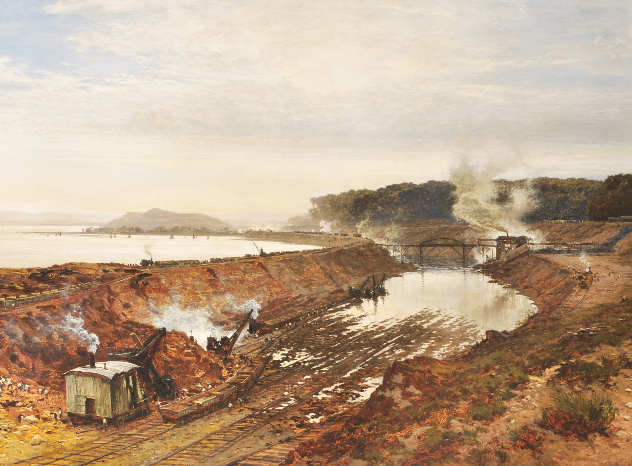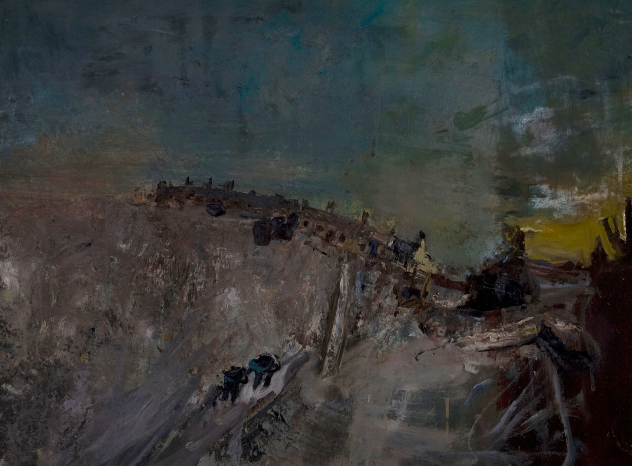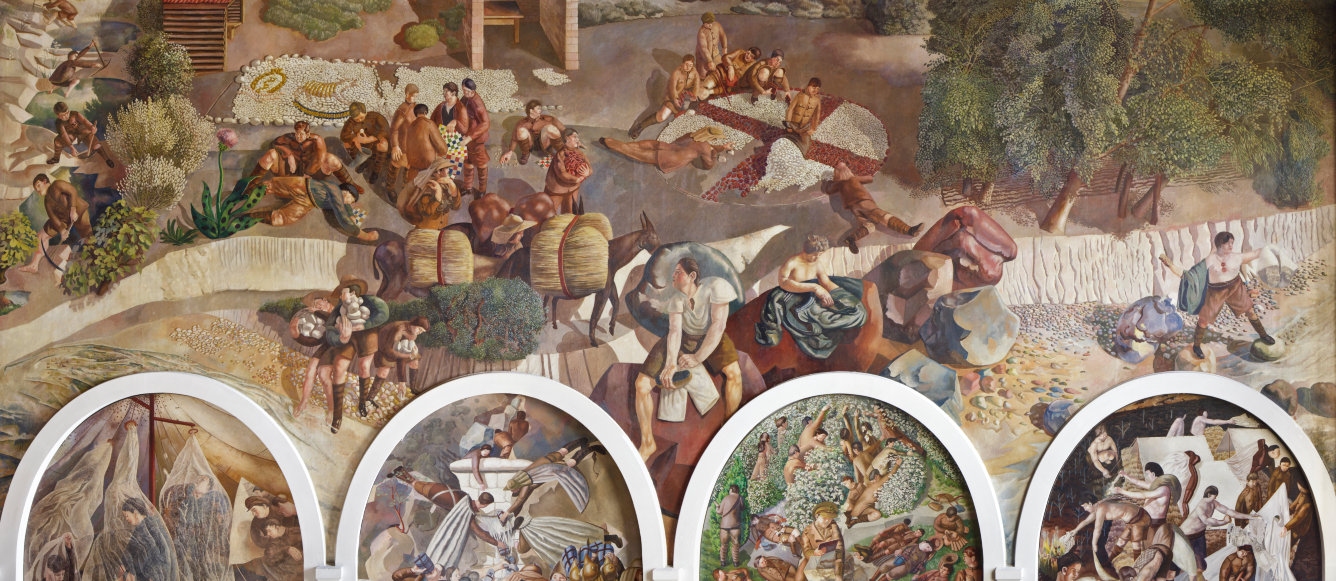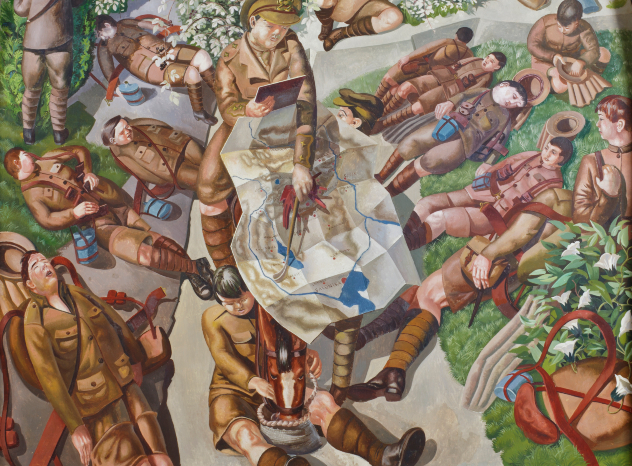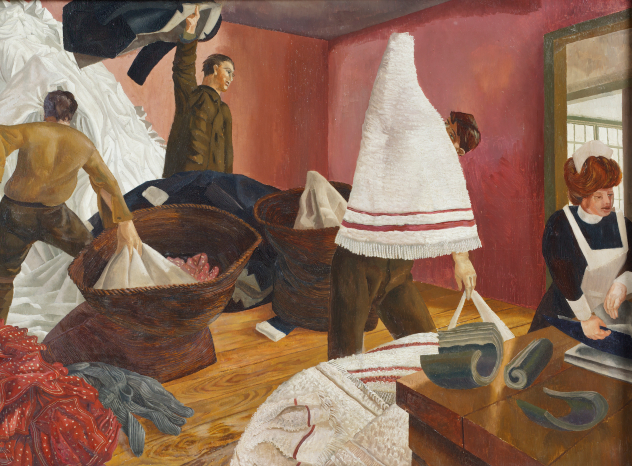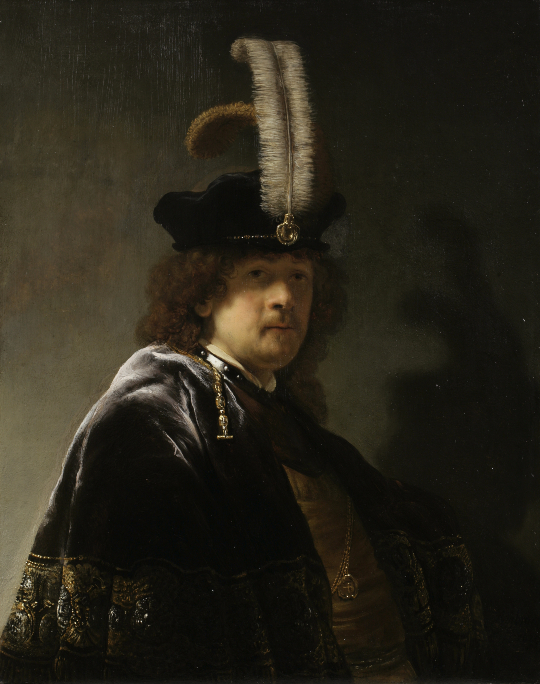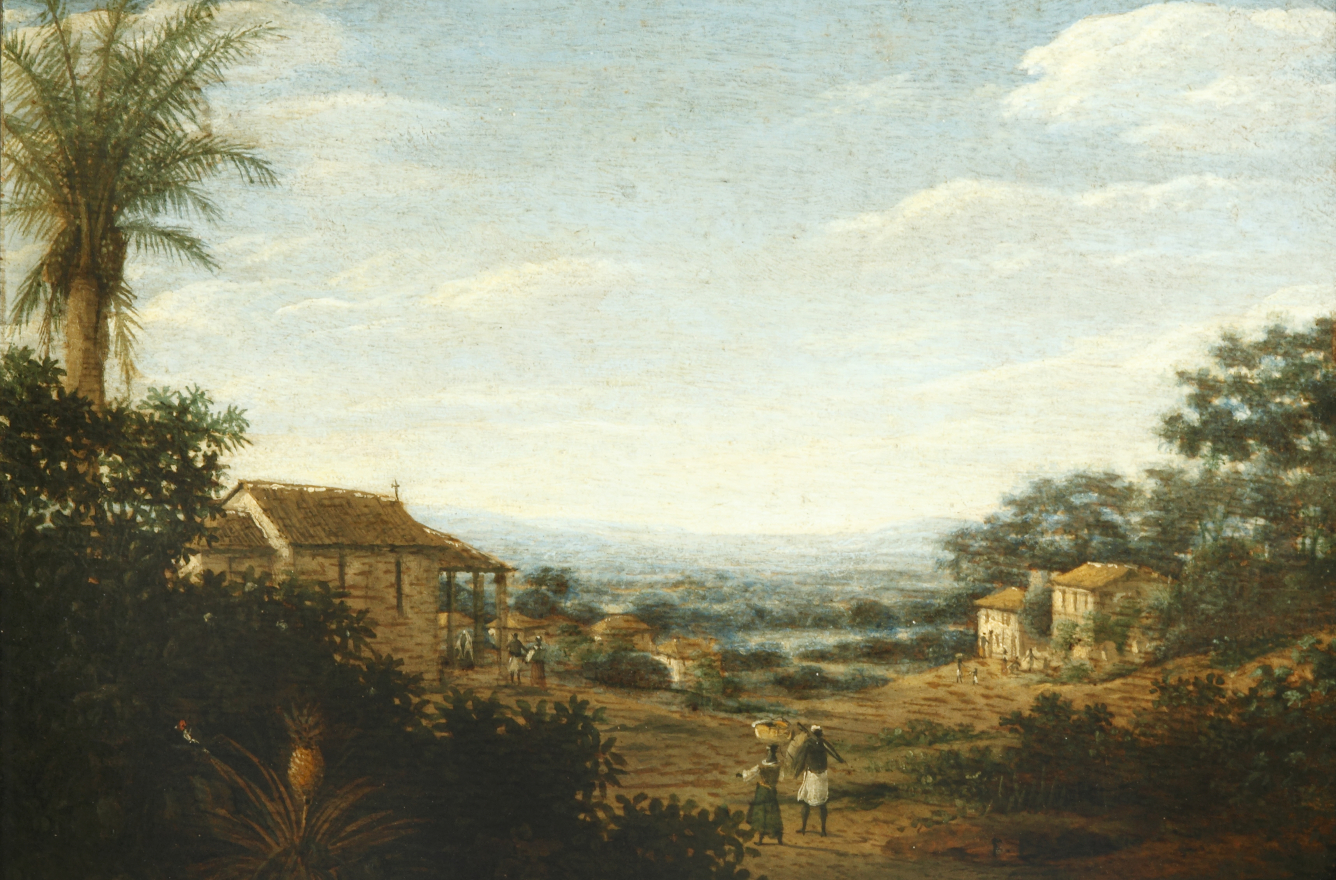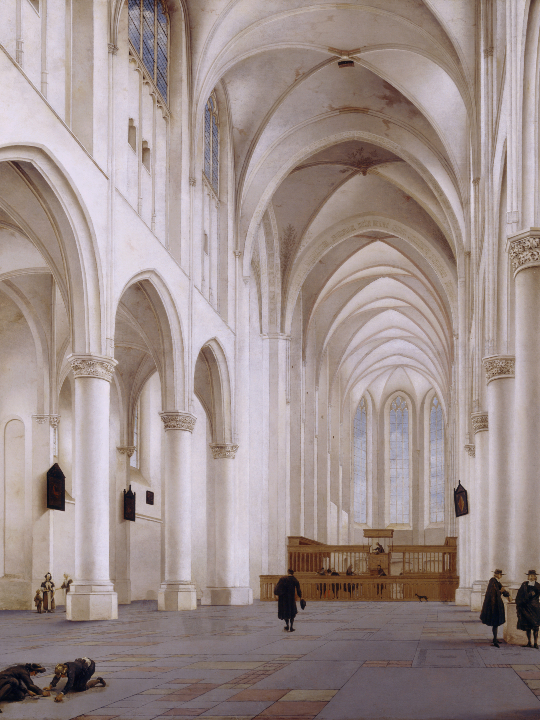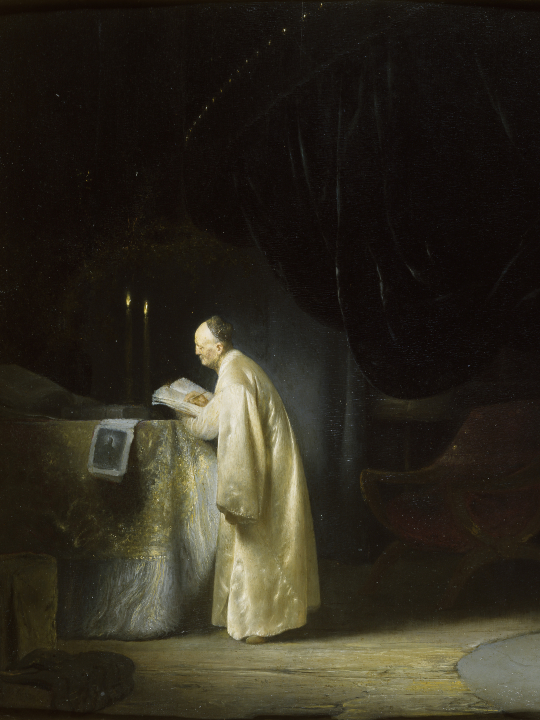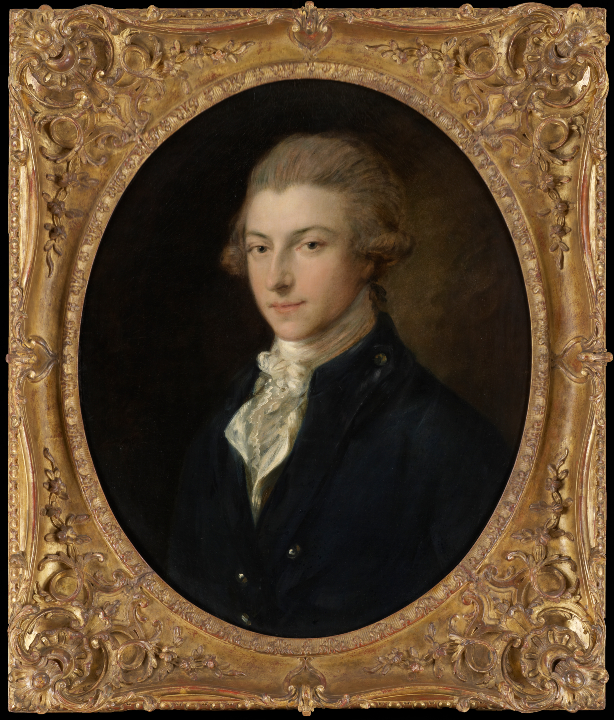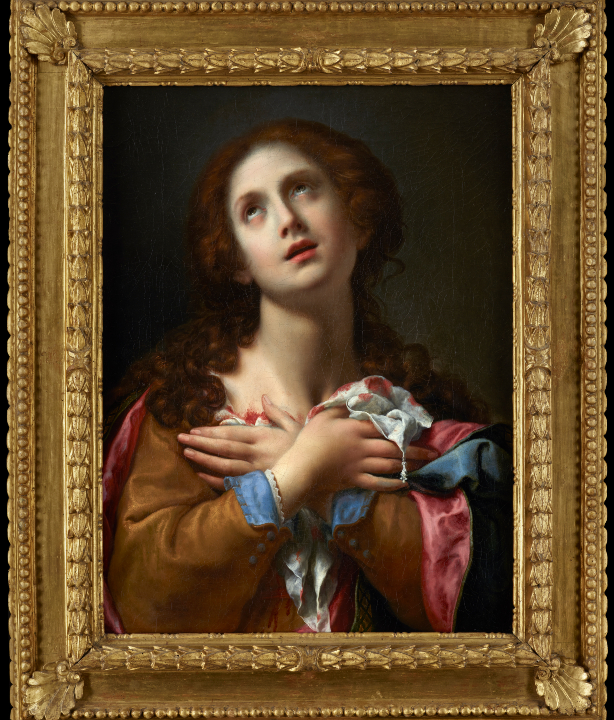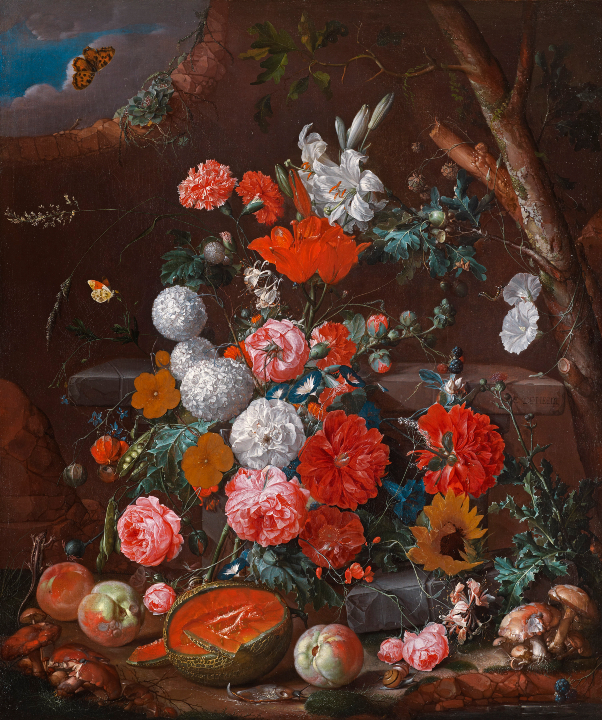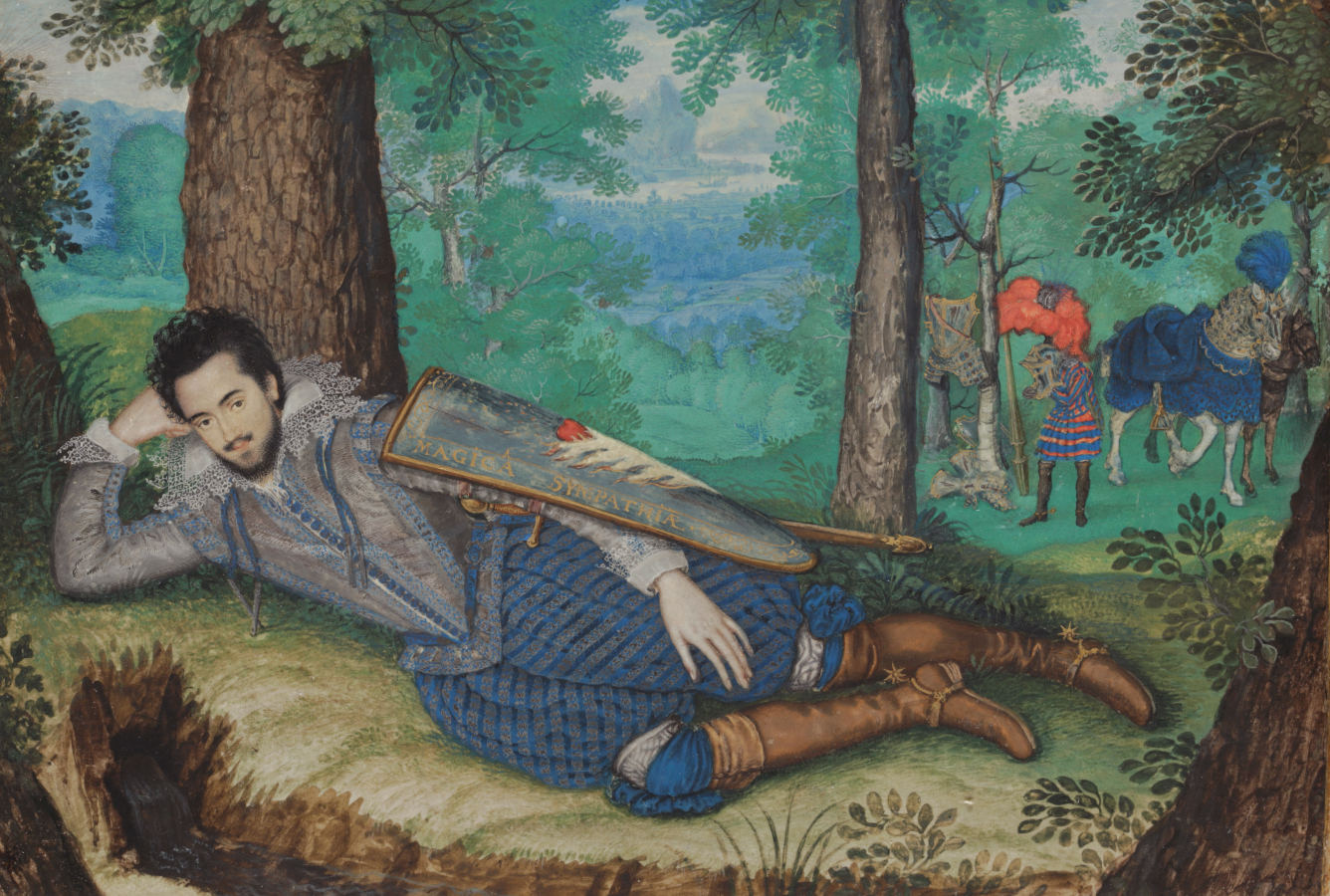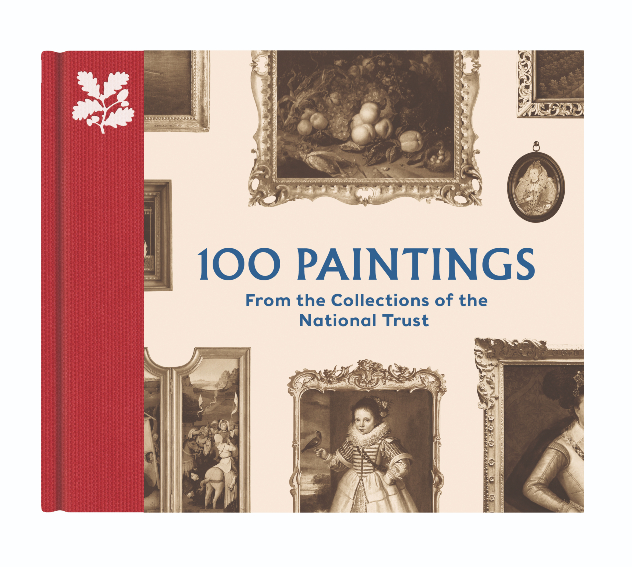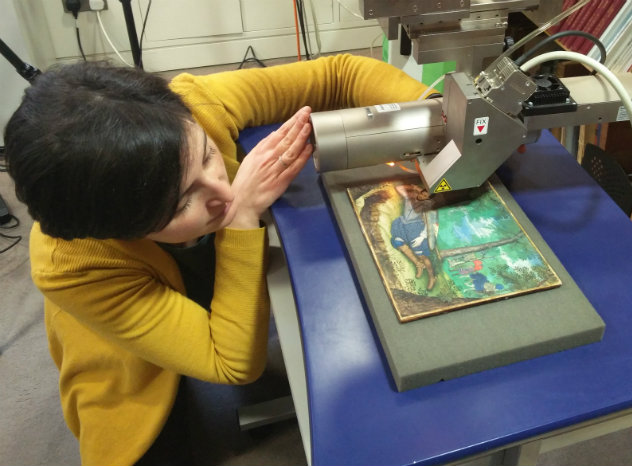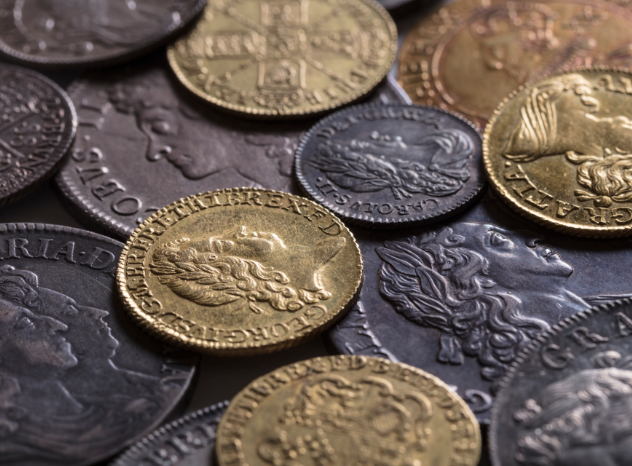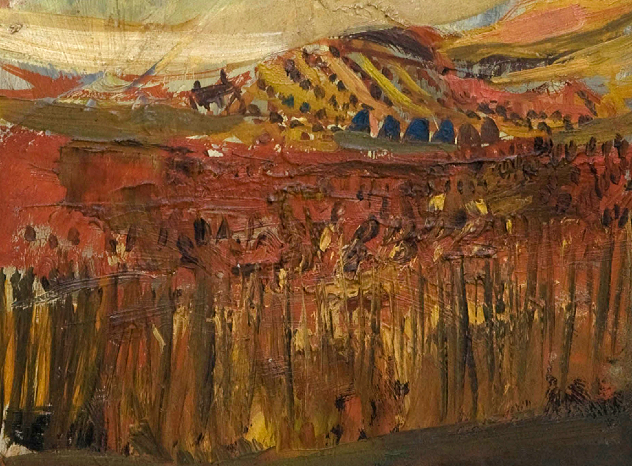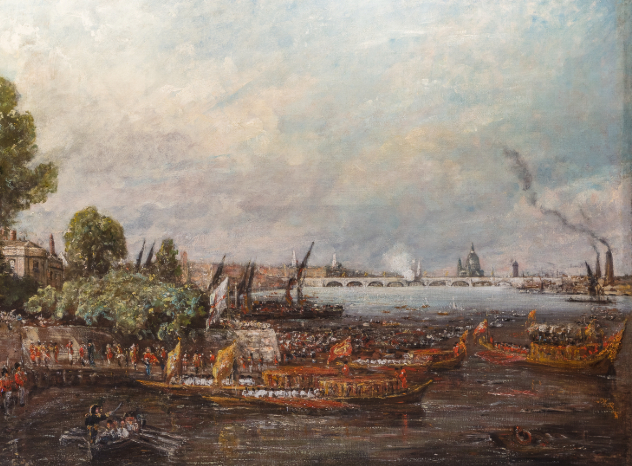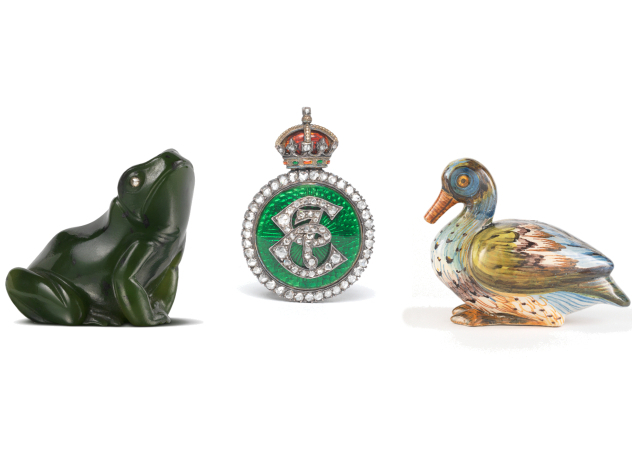The National Trust’s paintings collection comprises a unique holding of around 13,500 works which exemplify British collecting tastes from the fifteenth to twentieth centuries.
Many of the paintings still hang in rooms in which they were displayed historically, some even in spaces or within decorative schemes for which they were first commissioned or collected. These range from works of mainly local interest to some of the greatest masterpieces in the history of Western painting.
Masterpieces
The collection at Upton House, one of the Trust's finest discrete collections of Old Master paintings, includes The Dormition of the Virgin (c.1564) by Pieter Bruegel the elder, one of only three existing grisaille paintings by the great Netherlandish artist. (1)
The picture, painted in shades of grey and white, shows the deathbed of the Virgin Mary who, in her final moments, receives a lighted taper from Saint Peter and has her pillows plumped by Mary Magdalene. Earlier versions of this subject limited the number of deathbed attendants to the apostolic number of twelve, but in the Upton picture, Breugel has turned the biblical scene into a domestic event. Numerous men and women have been admitted to witness the Virgin's death which is set in a building in the Low Countries.
The National Trust has several pictures by Titian, the most celebrated painter in Renaissance Venice, including his pensively authoritative portrayal of Nicolò Zen, painted c.1560-65, in the collection at Kingston Lacy. Zen was a magistrate and a member of the Council of Ten, the governing body of the Republic of Venice, and he was an ambassador to the court of the Holy Roman Emperor Charles V. The portrait was bought by William Bankes in Bologna from the Marescalchi collection, as an unknown senator of the Savorgnan family. It was recently identified as the lost portrait of 'M. Niccolò Zono', mentioned in Giorgio Vasari’s 1567 biography of the artist.
Amongst the many other treasures at Kingston Lacy are two of the finest portraits that the celebrated Flemish painter Sir Peter Paul Rubens painted during one of his productive visits to the Italian city of Genoa. The portraits are thought to show Marchesa Maria Serra Pallavicino (signed and dated 1606) and Marchesa Maria Grimaldi (c.1607). Both women are shown sumptuously dressed, wearing huge wheel ruffs around their necks, and seated in fictive palatial settings.
Charles II’s Principal Painter, Sir Peter Lely is well represented in National Trust collections, not least at Ham House, which contains his magnificent c.1672 portrait of his great patroness, Elizabeth Murray, Countess of Dysart and Duchess of Lauderdale. She appears with her second husband, John Maitland, Duke of Lauderdale, before a landscape that includes an imaginary palace to highlight their elite status. The duke wears a dark suit, decorated with the star, sash and garter of the Order of the Garter, while the duchess is shown in a fashionable state of undress, with loose hair.
Other portraits she commissioned show political allies, including fellow Scots, and family members. This last group includes her brother-in-law, the royalist general Sir William Compton, painted at the end of the 1650s, and her daughter Lady Elizabeth Tollemache, later Duchess of Argyll, painted in the 1670s.
Spanish pictures
The National Trust’s collection includes a fine group of Spanish masters, displayed in a number of houses. These include an autograph replica of El espolio by El Greco at Upton House. This is a reduced version of an early, major commission that El Greco painted for the sacristy of Toledo Cathedral in Spain. Christ is shown serenely staring towards heaven as he is disrobed prior to his crucifixion and tormented by a jostling crowd of soldiers and onlookers.
The great court painter Diego Velázquez is represented at Ickworth by his portrait of the young heir to the Spanish throne, Prince Balthasar Carlos, posing outdoors before a hunt, holding a rifle and surrounded by three dogs. This picture, probably from the Spanish royal collections, is an earlier version of the well-known portrait on display at the Prado Museum in Madrid. Both show the Guadarrama mountains in the background.
Another portrait by Velázquez at Kingston Lacy is his portrait of Cardinal Camillo Massimi, painted during the artist’s second visit to Italy. Velázquez depicts Massimi in his resplendent peacock blue robes that he would have worn as private chamberlain to Pope Innocent X.
Another work in the collection of Spanish pictures at Kingston Lacy is a copy of Velázquez's masterpiece Las Meninas, painted by his son-in-law and successor as painter to the crown, Juan Bautista Martínez del Mazo. This much smaller version, squared out for Mazo to copy the original work, shows Velázquez painting in the Alcázar palace in Madrid, with the Infanta Margarita and her handmaids (the ‘meninas’ of the picture’s title) amongst other courtiers nearby. It was bought by William Bankes in 1811, who thought it was a sketch by Velázquez, calling it ‘the glory of my collection’.
Dyrham Park’s An Urchin mocking an Old Woman eating Migas by Bartolomé Esteban Murillo is typical of the artist's scenes of street children in his native Seville. In this picture, a young ruffian points and laughs at an old woman, who nervously guards her bowl of migas (a traditional Spanish dish using leftover bread).
The painting may have been purchased by William I Blathwayt (?1649–1717), perhaps from his uncle Thomas Povey, from whom he bought many of his pictures. Alternatively, it may have been acquired through the Flemish artist Jan Siberchts (1627–1703), who seems to have acted as a dealer for Blathwayt. If this Murillo did form part of William I Blathwayt’s collection, it would have been one of the earliest paintings by the Spanish artist to enter an English collection.
Eighteenth- and Nineteenth-century portraits
Sir Joshua Reynolds, one-time president of the Royal Academy in London, was the leading portrait painter at the end of the eighteenth century and he is well represented in the National Trust’s collections. In his portrait of The Hon. Theresa Robinson, Mrs John Parker of c.1770-72 at Saltram, the sitter is depicted leaning on the pedestal of an antique urn, and posed as if feeling her pulse. Reynolds' composition shows the sitter in profile, a representation that was often used for funerary images. This proved to be a portentous choice as Theresa died just three years after the portrait was completed.
At Uppark is the fashionable portrait of Sir Harry Fetherstonhaugh, painted in Rome in 1776 by Pompeo Batoni (who painted other members of the Fetherstonhaugh’s family) during the sitter’s Grand Tour of the Continent. The sitter echoes the portrait of Theresa Parker by Reynolds, leaning on the pedestal of a krater (an antique vase). He rests his hand on the shoulder of a bull mastiff that wears a collar bearing his master’s name.
The Swiss-born Angelica Kauffman was one of the most prominent artists working in England in the eighteenth century. She was one of only two founding female members of the Royal Academy in London and, astoundingly, the last woman to be admitted to the academy until 1922.
Kauffman's Self-portrait of the Artist hesitating between the Arts of Music and Painting was painted in Rome in 1794, where she settled in her later years. The painting is an allegorical depiction of the choice she had made early in life between her talents for music and art. The seated figure of music makes her case imploringly but painting, gesturing to a more difficult but more rewarding path, has won the day. Kauffman steps in the direction of painting but looks ruefully back.
Landscape
The National Trust’s picture collection includes fine examples by some of the greatest landscape painters that worked in Britain, as well as from further afield. The celebrated Antonio Canaletto is represented by his 1730 The Grand Canal, Piazzetta and Dogana, Venice at Tatton Park. This view of the Grand Canal was painted at a time when he was producing canvases for elite English patrons. It is one of two works painted by Canaletto for Samuel Hill of Tatton Park and aqcuired with the help of Joseph Smith, the English Consul in Venice, who often found buyers for Canaletto.
Jakob Hackert’s 1799 View of Excavations at Pompeii at Attingham Park shows a view down on to the ancient town from a nearby hilly vantage point. Images such as these were popular with British Grand Tourists – they revealed their fashionable tastes as well as a genuine fascination in the Roman town of Pompeii as an archaeological site, having been engulfed by ash from the devastating eruption of Vesuvius in AD 79. The picture is one of ten Italian views by Hackert at Attingham, and it is paired with his The Lake of Avernus of 1800. Thomas Noel Hill, 2nd Lord Berwick probably bought the two pictures in 1802. Hackert seems to have completed the canvases in Paris, having fled Naples at the Napoleonic invasion of that kingdom.
Anglesey Abbey's The Embarkation of George IV from Whitehall: the Opening of Waterloo Bridge, 1817 by John Constable depicts the Prince Regent opening the eponymous bridge on the second anniversary of the battle of Waterloo. Constable was present at the opening and produced a number of works inspired by the subject. Remarkably, this large painting is not a finished work of art but a full-scale sketch for the ultimate version, now in the Tate collection. Despite its imposing dimensions, it retains the freedom and spontaneity of a preparatory work.
The Lake, Petworth, Sunset, Fighting Bucks (c.1830) by Joseph Mallord William Turner was commissioned by one of the artist's great patrons, George Wyndham, 3rd Earl of Egremont (1751-1837). The 3rd Earl hosted Turner at Petworth on many occasions and allowed him to use a room in the house as a studio. The picture shows the lake in the park at Petworth. On the right, there are sheep and deer on the slopes of the hill. Deer are scattered throughout the park, including two white fallow bucks, engaged in a fight. To the left of the composition there is a bucolic scene of a crowd watching a cricket match.
An example of the industrialisation of the English countryside as the subject for a large scale landscape is The Excavation of the Manchester Ship Canal from 1890 by Benjamin Williams Leader showing the famous ship canal being constructed. It was commissioned by Wilbraham Egerton, 2nd Baron and 1st Earl Egerton of Tatton. This picture reveals Leader to be a more powerful and gritty artist than his more popular work, February, Fill Dyke (Birmingham Museums Trust), might suggest.
Mottisfont's Catterline in Winter (c.1960–1963) by Joan Eardley shows the Scottish east coast village on a stormy day. Catterline in Aberdeenshire was the subject of many of Eardley’s paintings, and she became the central figure in a group of artists known as the Catterline School. She would often strap her canvases to large boulders on the beach below the village in order to paint Catterline in particularly bad weather. This landscape, painted during the last years of Eardley’s life, is a rare example of a modern Scottish landscape in the National Trust's collection.
Stanley Spencer (1891–1959) and the Sandham Memorial Chapel
A highlight of British 20th-century painting is the decorative scheme produced by Stanley Spencer between 1927 and 1932 for the Sandham Memorial Chapel in Burghclere, Hampshire. The chapel was built by Mary Behrend and her husband, to memorialise her brother, Lt. Henry W. Sandham, who died of an illness he contracted during the Macedonian campaign in the First World War. Spencer was commissioned to provide a decorative cycle of paintings for the chapel, comprising three murals (including his monumental The Resurrection of the Soldiers), eight round-arched canvases and eight predella canvases, all based on his own experiences of the war. The result is justly considered to be Spencer’s masterpiece and is one of the most moving painted depictions of the Great War.
Golden Age Dutch pictures
A particular strength is a discrete group of seventeenth-century Golden Age Dutch pictures, collected and lived with by owners and patrons associated with Trust houses, for over four hundred years.
The recently-reattributed Self-portrait, wearing a Feathered Bonnet by Rembrandt at Buckland Abbey is a highlight. The affirmation of the authorship, reached by thorough technical analysis, adds this later 1630s portrait to the existing group of self-portraits that the celebrated artist produced over his long career. It also becomes the only autograph Rembrandt in the Trust's collection. The picture is an example of a tronie, a popular type of figurative painting in the Netherlands which shows a person playing a role or dressed in a fanciful costume.
Ham House's A Village in Brazil (c.1675) by Frans Post is a rare example of the artist’s work in a British collection. Post travelled with Johan Maurits, Count of Nassau-Siegen to north-east Brazil in the late 1630s, which was then a Dutch colony. There he painted Brazilian scenes, the first oil-painted landscapes depicting the new world. He painted such scenes for the rest of his career, after returning to the Netherlands in the earlier 1640s, including the tiny cabinet picture at Ham. This was bought by the Duchess of Lauderdale within the artist’s lifetime and has been at Ham House ever since.
Another highlight is the magnificent Interior of the Church of St Catherine, Utrecht by Pieter Saenredam at Upton House. It shows the carefully-observed perspective of the whitewashed church interior, reproduced in fine detail. The scene includes figures making a brass rubbing on the church floor, and a tiny dove perched high up in the triforium.
Also at Upton House is the enigmatic A Magus at a Table by Jan Lievens. It was painted during a period when Lievens shared a studio in Leiden with his friend Rembrandt and when their painting styles were remarkably similar. This painting, once thought to be by Rembrandt (the panel includes a false Rembrandt signature) is the original of the many versions of this composition that exist. One copy was listed in the inventory taken of Rembrandt’s possessions in 1656. The painting depicts a priest, or magus, standing before a table. The skull cap he wears and the books on the table suggest he is a scholar, although his gold gown and the gold brocade table covering would be unusually opulent for such a person.
Another fine acquisition made in recent years is the c.1780 portrait by Thomas Gainsborough of Louis-Pierre Quentin de Richebourg, Marquis de Champcenetz (1754–1822), a courtier in pre-Revolutionary France, which has returned to Knole. Champcenetz was also a soldier who fought in the American War of Independence. He later served as Governor of the Tuileries Palace where he survived an assault by revolutionary forces on 10 August 1792; by concealing himself amongst the dead, he fled to England. The picture was first recorded at Knole, where Champcenetz was a frequent visitor, in the possession of his friend, John Frederick Sackville, 3rd Duke of Dorset (1745–1799), who had himself been British Ambassador at the court of Louis XVI. The portrait was acquired in 2016 with contributions from a fund set up by the late Hon. Simon Sainsbury, from the Winchelsea National Trust Centre and Association and from other gifts and bequests.
In 2019, a painting by Italian artist Carlo Dolci (1616–1687) of the early Christian martyr Saint Agatha was acquired by the National Trust for Osterley Park and House in Middlesex thanks to a grant from the Art Fund and other generous donations. The painting was purchased by Sir Robert Child (1674–1721) at the beginning of the 18th century and became one of the works in a great picture collection at Osterley. It was recorded in a 1782 inventory, however, it was later sold along with other family heirlooms in the 1930s.
The painting is a dramatic depiction of Agatha of Sicily, a Christian martyr, who suffered dreadful torture at the hands of the Romans. It is an example of the work of the Baroque master Carlo Dolci, a leading figure of 17th-century Florentine art, whose passionate depictions of holy figures aimed to inspire reverence and empathy for the divine. It captures the miraculous moment when Saint Peter the Apostle appeared to Saint Agatha in a vision and healed her wounds.
Acquisitions
The National Trust adds to its collection, predominantly by acquiring works that have been lost to individual houses, through sales or inheritance. A number of key works have been acquired by the Trust in recent years including a spectacular flower painting by Cornelis De Heem at Dyrham Park. His c.1685 A Still Life of Flowers and Fruit arranged on a Stone Plinth in a Garden, with its rotting fruit and encroaching weeds, is an example of a vanitas picture. This moralising imagery reminds the viewer that earthly goods are no more than fleeting vanities and that all life comes to an end. It was probably painted around the time of King William III’s accession to the English throne, and it was originally owned by his Secretary at War, William Blathwayt of Dyrham Park, for which it has been recently re-acquired. In 2015 the picture was bought by the National Trust with funds from the National Heritage Memorial Fund, the Mr and Mrs Kenneth Levy bequest, the Art Fund, a fund set up by the late Hon. Simon Sainsbury, the Royal Oak Foundation and a private donation.
One of the most spectacular acquisitions made for the National Trust’s collection in recent years is the iconic Jacobean miniature by Isaac Oliver of Sir Edward Herbert, later 1st Lord Herbert of Cherbury (1581/2–1648), which can be seen at Powis Castle in Wales. This spectacular miniature shows Herbert as a melancholic lover, fashionably resting his head on one hand as he reclines in a forest glade, next to a stream. The shield strapped to his left arm is decorated with an image of a heart surrounded by flames, and is inscribed with the motto ‘MAGICA SYMPATHIAE’. The background comprises a view through the trees to a distant river and mountains, and in the middle ground a grooms attends to two horses, caparisoned for a joust. One of the finest miniature portraits in British art, it was acquired in 2016 by the National Trust by private treaty, with the help of grants from the National Heritage Memorial Fund, the Art Fund, a fund set up by the late Hon. Simon Sainsbury and a bequest from Winifred Hooper.
Notes
(1) The others are in the Courtauld Gallery in London and the Frick Collection in New York.
Further reading
100 Paintings from the Collections of the National Trust showcases 100 paintings from the vast collections of the National Trust – one of the largest, most significant holdings of fine art in the world.
Spanning the 14th to the 20th centuries, 100 Paintings from the Collections of the National Trust includes works by some of the most renowned European artists of all time including Titian, El Greco, Holbein, Rubens, Van Dyck, Rembrandt, Velázquez, Gainsborough, Reynolds, Canaletto, Hogarth, Stubbs, Angelica Kauffman, Edward Burne-Jones, James Tissot, Max Ernst, Vanessa Bell, Barbara Hepworth and Stanley Spencer, to name but a few.
Written by Dr John Chu (Senior National Curator, Midlands (Pictures & Sculpture) at the National Trust) and David Taylor (former Curator of Pictures and Sculpture at the National Trust), the book is structured chronologically, with each featured painting accompanied by an illuminating, easy-to-read caption. It concludes with a handy glossary of terms and a list of National Trust properties that house important paintings.
